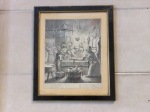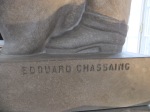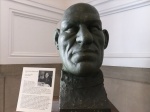Physicians have used art to teach anatomy and understand the workings of the human body for millennia. Artists like Leonardo daVinci have been fascinated with the human body and use it as the centerpiece of their works. The founders of the International Museum of Surgical Science incorporated art throughout the museum to help people understand the invisible concepts of anesthesia and asepsis.
First Floor to Second Floor Landing
Egsbert van Heemskerck Anthropomorphic Etchings
These etchings were done by one of the three Egbert van Heemskercks: the grandfather, the Elder, the Younger. These Dutch artists lived from the late 1500s to around 1700. All three artists incorporated medical themes in their work. The Elder may be the creator of these satirical engravings. The originals were copper engravings in a set of at least 12. Barber shops, an army recruiting hall, academia, liquor stores, and concert halls were also satirically anthropomorphized.
Second Floor
Hall of Murals
The Hall of Murals was one of the original museum exhibits. Gregorio Calvi di Bergolo (1904-1994) , an Italian painter, was commissioned in 1953 to paint these twelve oil murals that illustrate historical achievements in surgery and medicine. Calvi de Bergolo was a member of a noble Italian family and studied to become an ambassador. He decided that he preferred art to diplomacy and became known for his landscapes depicting roads and paths that disappear into the countryside. In 1950, he painted a portrait of A. Mario Dogliotti, the President of the International College of Surgeons, which may be why Calvi de Bergolo was chosen to execute these murals.
Hall of Immortals
Sculptor: Louis Linck
Skilled in math and art, Louis Linck (1895-1962) graduated from Paris University with a degree in engineering. During World War I, Linck served as a map-maker and decided to become an artist when the war ended. After winning a sculpture contest in 1926, Linck came to the United States to work on the exterior of the Wrigley Building. He may have met Edouard Chassaing at that time. Also in the 1930s, Linck met Dr. Max Thorek, founder of the museum, at a Chicago French Club gathering. Their social acquaintance may have led to Linck and Chassaing receiving the commission for the museum’s sculptures. Linck created the Lister, Pare, Roentgen, Curie, Vesalius, Hippocrates, and Asclepius statues.
Sculptor: Edouard Chassaing
Originally planning to become an engineer, Edouard Chassaing (1895-1974) turned to sculpture after winning a prize in Paris. He studied at the Nationale des Arts Decoratif and the Ecole de Beaux Arts before coming to the United States in 1927 to work on the exterior of Chicago’s Wrigley Building. He eventually became the sculpture supervisor for the WPA/FAP program in Chicago, serving from 1938 to 1941. He also taught sculpture at the Art Institute and invented a poured-stone process to craft sculptures. Chassaing created Hope and Help (in front of the museum), Imhotep, Morgagni, Pasteur, Galen, Semmelweiss, and Harvey.
Claudius Galen
Beginning his career as physician to the gladiators, Galen (129-216) dissected animals and believed that animal anatomy was the same as human anatomy – a belief that influenced the medical profession until Vesalius began dissecting human corpses. Galen’s greatest contributions were discovering that arteries contain blood not air and that nerves make muscles move.
Andreas Vesalius
Known for performing extensive dissections on the corpses of executed criminals, Vesalius (1514-1564) revolutionized the study of human anatomy. He used the human body itself as the basis of his illustrations, rather than animals as Galen had.
Third Floor
Urinary & Reproductive Room
Quevado Caesarian Section Painting
Commemorating the first Caesarian section done in Colombia, this Enrique Grau mural was also used as a Colombian postage stamp. Dr. Jose Ignacio Quevado performed this Caesarian section in 1944. The mural vividly depicts how the operation was conducted without anesthesia. The men are holding down the woman who was drugged with mandragora, the root of the mandrake plant, as seen in the basin at the far left of the mural. Her senses were dulled, but she wasn’t anesthetized as we know it. The monk is praying over the woman and possibly given her the last rites. The artist Enrique Grau (1920-2004) received a scholarship from the Colombian government to study at the Art Students League in New York. After returning to Colombia, Grau is credited with introducing international influences into Colombian art.
Ovariatomy Painting
The mural on the south wall commemorating the first Colombian ovariatomy depicts a fully anesthetized patient. An ether or chloroform-soaked cloth covers the patient’s face. Medical students replace the monk from the Caesarian Section murals. An anesthetist attends to ether or chloroform bottles. Eduardo Ramirez Villamizer (1923-2004) originally planned to become an architect but switched to painting. By the late 1950s, he abandoned painting and became a sculptor.
Third Floor to Fourth Floor Landing
Maurice Tillet Bust
Maurice Tillet (1903-1954) is best known as the 1940’s-era professional wrestler nicknamed The French Angel. He also suffered from acromegaly, a rare disease in which bones grow uncontrollable. His disfigured appearance drove him to a career in wrestling, but Tillet was also a cultured, intelligent man who spoke 14 languages and wrote poetry. He became friends with sculptor Louis Linck, who sculpted this bust a few years before Tillet’s death.
Fourth Floor
Cardiovascular Room
Contributed by the Spain delegation of the International College of Surgeons, the murals in this room depict the development of Spanish medicine and surgery. Fernando Escriva (1915-1977) painted these murals, which were completed in 1958.
Anatomy Theater
Theater at Padua Model
Andreas Vesalius performed public dissections in this replica of Padua’s Anatomical Theater. Constructed in 1446, Vesalius, Harvey, and Morgagni dissected, studied, and taught anatomy to medical students. Politicians and honored guest also observed the dissections. The general public would hold candles to illuminate the theater during the operations.
Vesalius Illustrations
Andreas Vesalius convinced judges to give him the corpses of condemned criminals for dissection purposes. Using those fresh cadavers, he discovered errors in ancient medical texts and published his controversial De Humani Corporis Fabrica in 1543.
Netter Illustrations
Dr. Frank Netter (1906 -1991) began his illustrious career as a medical illustrator while in medical school. He illustrated articles and textbooks to pay the tuition for his surgical studies. After serving in the army during World War II, Dr. Netter decided to devote himself to medical illustrations. The 13 book Netter Collection of Medical Illustrations includes over 20,000 paintings. The Netter Atlas of Human Anatomy has been translated into 16 languages.











